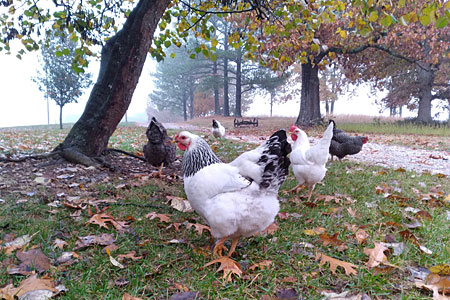
What exactly are heritage chickens? For that matter, what is a heritage turkey, duck, or goose? By definition, heritage poultry breeds share these important characteristics:
- They are standard breeds
- They mate naturally
- They can live a long time
- They are slow growing
Standard Breeds
Heritage breeds must have been accepted into the American Standard of Perfection prior to the mid 1900s. They must meet the guidelines established for the breed, and have genetic lines tracing back multiple generations.
These early breeds were hearty, long-lived, and reproductively active. Unfortunately, many of these once-popular breeds have been replaced by closely held genetic lines that are bred for efficient industrial production. The result has been a loss in genetic variability, with the possible extinction of some breeds.
Natural Mating
Natural mating means all generations of a specific breed are the genetic result of the natural interaction between males and females of that breed. Heritage breeds are not the result of cross breeding or hybridization.
Therefore, the likes of Cornish cross broilers or production sex link hens are not heritage chickens. And heritage breeds do not result from artificial insemination, such as is practiced for commercially developed meat breeds like broad-breasted turkeys.
Long Lifespan
Heritage breeds are genetically able to thrive outdoors under pasture-based management and adapt to the local environment. They do not require climate-controlled confinement.
Being able to roam outdoors allows these birds to remain healthy by boosting immunity and providing opportunities for physical exercise. Heritage hens should continue to lay for 5 to 7 years. Roosters should remain fertile for 3 to 5 years.
Slow Growth
The relatively slow growth rate of heritage breeds allows time for the birds to develop a strong skeletal structure and healthy organs before they start building muscle mass. As a result, heritage breeds raised for meat reach harvest weight in no less than 16 weeks.
By comparison, industrially hybridized meat chickens may be ready for market in as little as 6 weeks. Any older and they are likely to develop health challenges, including lameness and heart failure.
Heritage Benefits
All these features add up to the sustainability of heritage breeds. They retain natural instincts to engage in normal poultry activities, such as foraging, raising young, and evading predators. As layers they may not produce as many eggs in a year as industrial hybrids. And as meat birds they don’t grow as big or as fast.
However, heritage hens enjoy a longer productive lifespan. And for meat production, the flavor is far superior. But one of the most important reasons to support heritage poultry is to help preserve the amazing genetic variety that gave rise to the countless number of breeds we know and love today.
Helpful Links
The Livestock Conservancy Defines “Heritage Breeds”
Differences Between Heritage Turkeys and Broad Breasted Turkeys
Which Is Best for Meat: Cornish Broiler or Heritage Breed?
Heritage Breeds Offered by Cackle Hatchery®
And that’s today’s news from the Cackle Coop.
Gail Damerow has written numerous poultry-keeping books, including Storey’s Guide to Raising Chickens.

